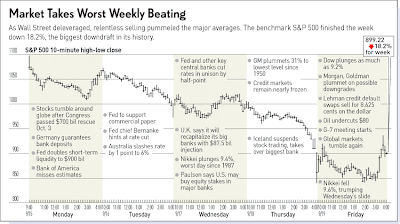
Monday, October 13, 2008
Market Monday's
Let's take several different looks at last week's action.
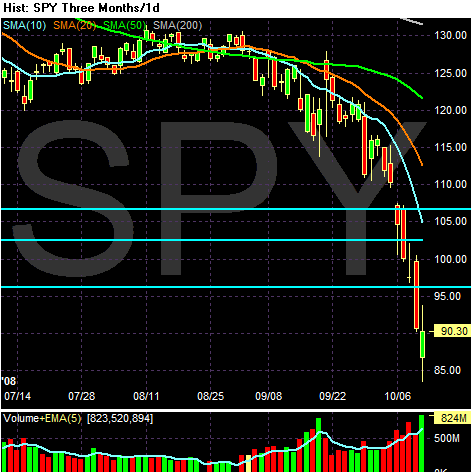
The daily chart shows a very bearish orientation. Prices are below all the SMAs, all the SMAs are headed lower, and the shorter SMAs are below the longer SMAs. But let's add a few points.'
1.) Notice there are two very long candles, which occurred on Tuesday and Thursday. There are bearish.
2.) Note the escalating volume that occurred throughout the week
3.) Note the market was down about 15% last week -- that's a huge drop.
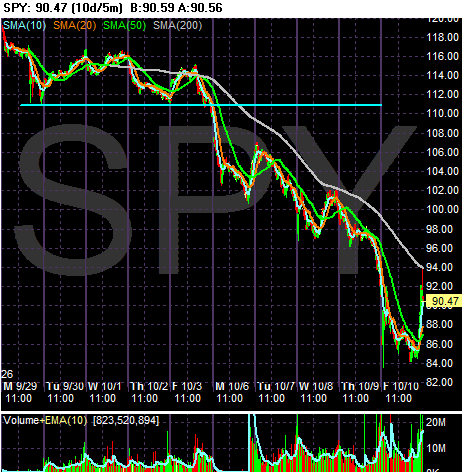
On the 10 day chart, simply notice that the week before last (the last week of September) the market stabilized a bit. Most of the damage was down last week.
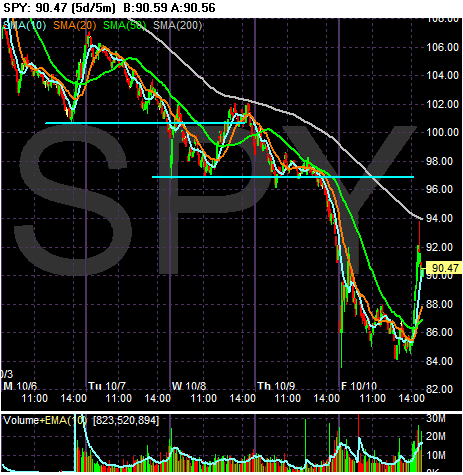
On the 5-day chart, notice there were two big moves lower last week. The first occurred from the beginning of Tuesday to mid-Wednesday. The second occurred from the beginning of Thursday to almost the end of Friday. Also note the market moved lower for most of Monday. In other words, far the majority of time last week the market was moving lower.
Keep in mind that with last week's action numerous people are looking for a reversal. Considering how oversold the market is at this point, that would make sense. However, I made the observation on Wednesday that I was expecting a reversal and look how far that went.

The daily chart shows a very bearish orientation. Prices are below all the SMAs, all the SMAs are headed lower, and the shorter SMAs are below the longer SMAs. But let's add a few points.'
1.) Notice there are two very long candles, which occurred on Tuesday and Thursday. There are bearish.
2.) Note the escalating volume that occurred throughout the week
3.) Note the market was down about 15% last week -- that's a huge drop.

On the 10 day chart, simply notice that the week before last (the last week of September) the market stabilized a bit. Most of the damage was down last week.

On the 5-day chart, notice there were two big moves lower last week. The first occurred from the beginning of Tuesday to mid-Wednesday. The second occurred from the beginning of Thursday to almost the end of Friday. Also note the market moved lower for most of Monday. In other words, far the majority of time last week the market was moving lower.
Keep in mind that with last week's action numerous people are looking for a reversal. Considering how oversold the market is at this point, that would make sense. However, I made the observation on Wednesday that I was expecting a reversal and look how far that went.
Friday, October 10, 2008
Weekend Weimar and Beagle
No pictures or movies today. I'm just glad this week is over.
I'll be on KTLK tomorrow morning for econ 101 with Johnny Wendell.
I'll be back on Monday.
Until then, relax as much as you can and think about anything except the market.
I'll be on KTLK tomorrow morning for econ 101 with Johnny Wendell.
I'll be back on Monday.
Until then, relax as much as you can and think about anything except the market.
This Week Has Done a Ton Of Technical Damage
Let's take a look at multi-year charts to see how the markets are looking.

As of this writing, the SPYs are at 85.9
Prices have moved through price levels established in 2002, 2004, 2005, 2006, 2007 and 2008.
Now we are looking to test lows established in 2003. That's when this multi-year rally started.

As of this writing, the QQQQs are at 30.10.
The QQQQs have moved through lows established in 2004, 2005, 2006, 2007 and 2008. Now the QQQQs are looking to test the high established at the end of 2002. Mercifully we still have a ways to go before we've wiped out this rally.
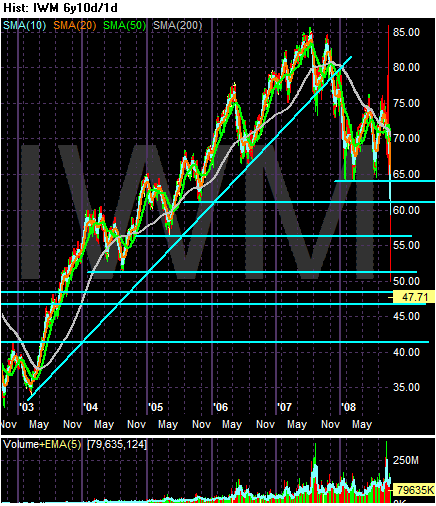
As of this writing, the IWMs are at 47.90.
The IWMs have moved through levels established in 2004, 2005, 2006 2007 and 2008. Now they are looking to test levels established in 2003.
That's a lot of wealth wiped out.

As of this writing, the SPYs are at 85.9
Prices have moved through price levels established in 2002, 2004, 2005, 2006, 2007 and 2008.
Now we are looking to test lows established in 2003. That's when this multi-year rally started.

As of this writing, the QQQQs are at 30.10.
The QQQQs have moved through lows established in 2004, 2005, 2006, 2007 and 2008. Now the QQQQs are looking to test the high established at the end of 2002. Mercifully we still have a ways to go before we've wiped out this rally.

As of this writing, the IWMs are at 47.90.
The IWMs have moved through levels established in 2004, 2005, 2006 2007 and 2008. Now they are looking to test levels established in 2003.
That's a lot of wealth wiped out.
Paul Volcker Has The Answer
Paul Volcker was the last great Chairman of the Federal Reserve. He was presented with a terrible situation -- stagflation, or weak growth and high inflation. He could only tackle one problem. He chose inflation. To combat the problem he increased interest rates to levels that caused a recession. In fact -- there were two recessions. However, 25 years later, we still have low inflation largely thanks to Volckers efforts. He deserves far more accolades than he receives.
In today's WSJ he offers something that is dearly lacking right now: hope that this situation will end. What has been dearly lacking from anybody (and I mean anybody in any party in any position anywhere) is leadership. Bush is a lame duck watching is legacy (what little is left) circle the bowl. Congress has lacked any dynamic leaders who inspire calm. Paulson attempted one of the largest power grabs in political economic history several weeks ago lowering his public perception. In short, there haven't been many adults anywhere to be found.
However, Volcker is an adult. His editorial is clear and decisive.
While there is concern on my part that Bush will do everything he can to prevent international coordination from occurring, the bottom line is circumstances may overpower him. Simply put -- he really doesn't have much choice right now.
The FDIC has been working overtime over the last year. Behind the scenes they have helped to arrange important mergers that kept deposit access seamless while preventing more hits to their capital. They deserve far more credit then they are getting.
There is now authority for the Treasury to take unprecedented moves in the markets. While some may not like this -- those arguing "socialism" etc -- they should simply be ignored. The bottom line is we are far past the point of ideology. We need solutions. What has been proposed so far is clearly insufficient to solve the task. We need far more direct intervention and participation.
In addition, there are other regulatory pieces in place. SIPC will help to prevent losses at brokerage firms should there be any problems. There is talk of insuring all bank deposits and debts. In other words -- we're moving in the right direction.
But we need leadership:
In today's WSJ he offers something that is dearly lacking right now: hope that this situation will end. What has been dearly lacking from anybody (and I mean anybody in any party in any position anywhere) is leadership. Bush is a lame duck watching is legacy (what little is left) circle the bowl. Congress has lacked any dynamic leaders who inspire calm. Paulson attempted one of the largest power grabs in political economic history several weeks ago lowering his public perception. In short, there haven't been many adults anywhere to be found.
However, Volcker is an adult. His editorial is clear and decisive.
First of all, there is now clear recognition that the problem is international, and international coordination and cooperation is both necessary and underway. The days of finger pointing and schadenfreude are over. The concerted reduction in central bank interest rates is one concrete manifestation of that fact.
While there is concern on my part that Bush will do everything he can to prevent international coordination from occurring, the bottom line is circumstances may overpower him. Simply put -- he really doesn't have much choice right now.
In the U.S., with higher limits of deposit insurance in place, the FDIC has demonstrated its ability to protect depositors, to arrange mergers, and to provide capital for troubled banks. Most other countries now have a comparable capacity.
Recent U.S. legislation has provided authority for large-scale direct intervention by the Treasury in the mortgage and other troubled markets. Along with increased purchases by Fannie Mae and Freddie Mac, now under government control, means of restoring needed liquidity are at hand.
Other key sectors of financial markets are now protected or supported by either the Treasury or Federal Reserve, specifically by temporary insurance of money-market funds and by direct purchase of commercial paper.
The FDIC has been working overtime over the last year. Behind the scenes they have helped to arrange important mergers that kept deposit access seamless while preventing more hits to their capital. They deserve far more credit then they are getting.
There is now authority for the Treasury to take unprecedented moves in the markets. While some may not like this -- those arguing "socialism" etc -- they should simply be ignored. The bottom line is we are far past the point of ideology. We need solutions. What has been proposed so far is clearly insufficient to solve the task. We need far more direct intervention and participation.
In addition, there are other regulatory pieces in place. SIPC will help to prevent losses at brokerage firms should there be any problems. There is talk of insuring all bank deposits and debts. In other words -- we're moving in the right direction.
But we need leadership:
None of that is easy. Some of it poses risks for the taxpayer. All of it is decidedly unattractive in the sense of large official intervention in what should be private markets able to stand on their own feet. Unattractive or not in normal circumstances, the point is the needed tools to restore and maintain functioning markets are there. Now is the time to use them. To that end, the immediate and critical need is determined, forceful and persistent leadership -- extending across administrations and Congresses. Both the public and private sectors must be involved
Forex Fridays

On the dollar's weekly chart, notice the following:
-- Prices have clearly broken through the multi-year downtrend
-- All the SMAs are moving higher
-- The shorter SMAs are above the longer SMAs
-- Prices are above all the SMAs
-- Prices are using the 10 week SMA as technical support

On the daily chart, notice the following
-- Prices are above all the SMAs
-- All the SMAs are moving higher
-- The shorter SMAs are above the longer SMAs
-- Prices have twice broken through technically important resistance levels
Bottom line: both of these charts are bullish.
Labels:
dollar
Thursday, October 9, 2008
Today's Markets
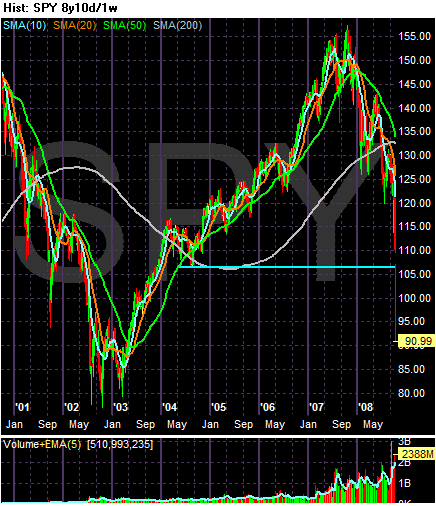
This is a multi-year chart. Notice that it's dropping off a cliff. Also note the volume -- it's huge.
The SPYs have dropped 42% since their highs a year ago.
I've got nothing left to say.
Subscribe to:
Posts
(Atom)